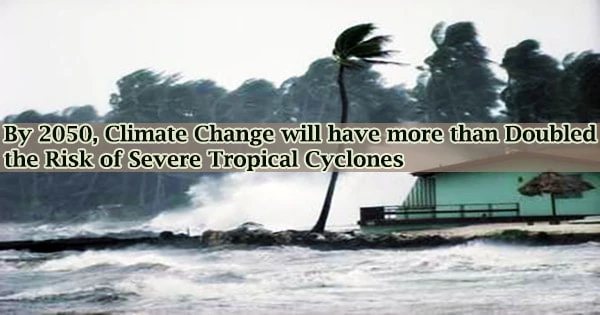According to a new study published in Scientific Advances, human-caused climate change would make strong tropical storms twice as often by the middle of the century, putting significant sections of the world at danger. According to the estimate, maximum wind speeds linked with these cyclones could increase by roughly 20%.
Tropical cyclones are relatively rare, while being among the world’s most devastating extreme weather phenomena. Only about 80-100 tropical cyclones form each year, with the majority never making landfall.
Furthermore, accurate worldwide historical records are lacking, making it difficult to anticipate when and where they may occur, as well as what steps governments should take to prepare.
To get around this constraint, an international team of scientists led by Ivan Haigh of the University of Southampton devised a new method that blended historical data with global climate models to create hundreds of thousands of “synthetic tropical cyclones.”
Dr. Nadia Bloemendaal from the Institute for Environmental Studies, Vrije Universiteit Amsterdam, who led the study, said:
“Our results can help identify the locations prone to the largest increase in tropical cyclone risk. Local governments can then take measures to reduce risk in their region, so that damage and fatalities can be reduced. With our publicly available data, we can now analyse tropical cyclone risk more accurately for every individual coastal city or region.”
Of particular concern is that the results of our study highlight that some regions that don’t currently experience tropical cyclones are likely to in the near future with climate change. The new tropical cyclone dataset we have produced will greatly aid the mapping of changing flood risk in tropical cyclone regions.
Dr. Ivan Haigh
The researchers were able to more accurately project the occurrence and behavior of tropical cyclones around the world in the face of climate change by creating a large dataset with these computer-generated cyclones, which have similar features to natural cyclones. This included regions where tropical cyclones hardly ever occur today.
According to the team’s findings, climate change will quadruple the frequency of the most powerful cyclones, those rated Category 3 or higher, while weaker tropical cyclones and tropical storms would become less prevalent in most of the world’s areas.
The Bay of Bengal will be an exception, since researchers discovered a drop in the frequency of strong cyclones there.
Low-income countries will be home to many of the most vulnerable areas. Countries like Cambodia, Laos, Mozambique, and numerous Pacific Island Nations like the Solomon Islands and Tonga, where tropical cyclones are relatively rare today, will face an increasing risk in the coming years.
Around the world, Asia will witness the greatest increase in the number of people affected by tropical cyclones, with millions more in China, Japan, South Korea, and Vietnam.
Dr. Ivan Haigh, Associate Professor at the University of Southampton, said:
“Of particular concern is that the results of our study highlight that some regions that don’t currently experience tropical cyclones are likely to in the near future with climate change. The new tropical cyclone dataset we have produced will greatly aid the mapping of changing flood risk in tropical cyclone regions.”
The research could aid governments and organizations in better assessing the danger of tropical cyclones, allowing for the creation of risk mitigation techniques to reduce damage and fatalities.





